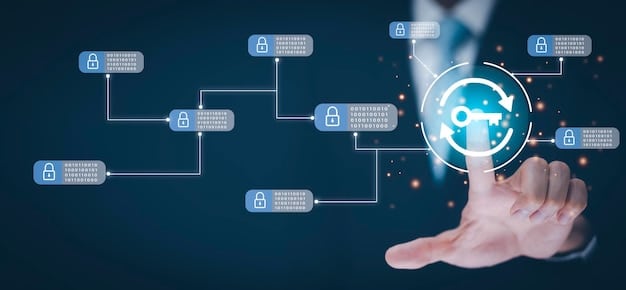Enhance Fintech Security: How Biometrics Prevent Fraud

Fintech companies can enhance security and reduce fraud by implementing biometric authentication methods such as fingerprint scanning, facial recognition, and voice analysis, which verify users’ identities more securely than traditional passwords or PINs.
The fintech industry is constantly evolving, and with that evolution comes the need for enhanced security measures. How can fintech companies use biometric authentication to enhance security and reduce fraud? By leveraging technologies like fingerprint scanning, facial recognition, and behavioral biometrics, fintech firms can provide a safer environment for their users and their assets.
Understanding Biometric Authentication
Biometric authentication is the process of verifying a person’s identity using unique biological traits. Unlike passwords or PINs, biometrics are inherently tied to the individual, making them much harder to replicate or steal. This technology has become increasingly vital in the fintech sector.
Using biometric authentication enhances security by making it more difficult for unauthorized users to access sensitive information. This not only protects customers but also builds trust in the financial services provided.
Types of Biometric Authentication
Several types of biometric authentication are available, each with its own strengths and applications. Here are a few of the most common methods used in fintech.
- Fingerprint Scanning: One of the most widely used biometric methods, fingerprint scanning is reliable and cost-effective.
- Facial Recognition: This method uses algorithms to identify and verify users based on their facial features.
- Voice Recognition: Voice recognition analyzes unique voice patterns to authenticate users.
- Behavioral Biometrics: Behavioral biometrics analyze how users interact with devices, such as typing speed and mouse movements.
Each type offers a unique approach to securing fintech platforms. Choosing the right method depends on the specific needs and risk profile of the company.

Benefits of Biometric Authentication in Fintech
Implementing biometric authentication offers numerous advantages for fintech companies, ranging from enhanced security to improved user experience. These benefits contribute to a more robust and trustworthy financial ecosystem.
By adopting biometric solutions, fintech companies can minimize fraud, streamline operations, and build stronger relationships with their customers. The advantages are clear and impactful.
Enhanced Security
One of the primary benefits of biometric authentication is the enhanced level of security it provides. Biometrics are difficult to forge, making it harder for malicious actors to gain unauthorized access.
Traditional methods like passwords and PINs are vulnerable to phishing attacks and brute-force attempts. Biometrics offer a more secure alternative, significantly reducing the risk of fraud.
Improved User Experience
Biometric authentication can also improve the user experience by making the login process faster and more convenient. Instead of remembering complex passwords, users can simply use their fingerprint or face to access their accounts.
- Convenience: Biometrics offer a hassle-free way to authenticate, saving users time and effort.
- Speed: Biometric verification is typically faster than traditional methods.
- Accessibility: Biometrics can be more accessible for users who have difficulty remembering passwords.
This enhanced user experience can lead to higher customer satisfaction and increased adoption of fintech services.
Implementing Biometric Authentication
Implementing biometric authentication requires careful planning and execution. Fintech companies need to consider various factors, including the type of biometric method, the integration process, and the user experience.
A well-thought-out implementation strategy can ensure a smooth transition and maximize the benefits of biometric authentication, leading to a more secure and user-friendly platform.
Choosing the Right Biometric Method
Selecting the appropriate biometric method is crucial for success. Factors to consider include the level of security required, the cost of implementation, and the user preferences.
Each method has its own strengths and weaknesses. For example, fingerprint scanning is cost-effective and reliable, while facial recognition offers a more seamless user experience. Consider these points.
Integration with Existing Systems
Integrating biometric authentication with existing systems can be complex. Fintech companies need to ensure that the biometric solution is compatible with their current infrastructure and that the integration process is seamless.
Proper integration can minimize disruptions and ensure a smooth transition to the new authentication method. This requires careful planning and collaboration between different departments.
User Education and Training
Educating users about the benefits of biometric authentication is essential for adoption. Fintech companies need to provide clear instructions and training on how to use the new authentication method.

Effective user education can increase acceptance and reduce resistance to change. This may involve creating tutorials, FAQs, and providing support channels.
Challenges and Considerations
While biometric authentication offers numerous benefits, it also presents some challenges and considerations. Fintech companies need to be aware of these potential issues and take steps to mitigate them.
Addressing these challenges proactively can help ensure the successful implementation and long-term sustainability of biometric authentication in the fintech sector.
Privacy Concerns
One of the main concerns surrounding biometric authentication is privacy. Users may be hesitant to share their biometric data, fearing that it could be misused or compromised.
- Data Security: Protecting biometric data from unauthorized access is crucial.
- Transparency: Being transparent about how biometric data is collected, stored, and used can build trust with users.
- Compliance: Ensuring compliance with privacy regulations is essential for maintaining user confidence.
Fintech companies need to implement robust security measures and be transparent about their data handling practices to address these concerns.
Accuracy and Reliability
The accuracy and reliability of biometric authentication methods can vary. Factors such as environmental conditions, user behavior, and the quality of the biometric data can affect performance.
Regular testing and calibration can help ensure that the biometric system maintains a high level of accuracy and reliability. This is necessary for an overall positive user experience.
Cost and Scalability
The cost of implementing and maintaining biometric authentication can be significant. Fintech companies need to consider the initial investment, ongoing maintenance costs, and the scalability of the solution.
Choosing a cost-effective and scalable biometric solution is crucial for long-term success. This involves carefully evaluating different vendors and their pricing models.
The Future of Biometric Authentication
The future of biometric authentication in fintech looks promising. As technology evolves, new and innovative biometric methods are emerging, offering even greater security and convenience.
Staying up-to-date with the latest trends and developments in biometric authentication is essential for fintech companies looking to stay ahead of the curve and provide the best possible security for their customers.
Advancements in Biometric Technology
Advancements in artificial intelligence (AI) and machine learning (ML) are driving significant improvements in biometric technology. These advancements are leading to more accurate and reliable authentication methods.
AI-powered biometric systems can learn and adapt to changes in user behavior, making them more resistant to fraud and spoofing attempts.
Integration with Emerging Technologies
Biometric authentication is also being integrated with other emerging technologies, such as blockchain and the Internet of Things (IoT). This integration is creating new opportunities for secure and seamless transactions.
For example, biometric authentication can be used to secure blockchain-based financial transactions and to verify the identity of users accessing IoT devices.
Increased Adoption
As the benefits of biometric authentication become more widely recognized, its adoption is expected to increase across the fintech sector. This increased adoption will drive further innovation and standardization in the industry.
More and more consumers are now familiar with using biometric authentication on their smartphones, that transferring into fintech services can make for a great user experience.
| Key Point | Brief Description |
|---|---|
| 🔒 Enhanced Security | Biometrics are harder to forge, reducing unauthorized access. |
| 👍 User Experience | Biometrics offer a faster, more convenient login process. |
| 🛡️ Privacy Concerns | Requires transparent data handling and robust security. |
| 🚀 Future Trends | AI, blockchain integration, and increased adoption. |
FAQ
▼
Biometric authentication is the process of verifying a person’s identity using unique biological traits, such as fingerprints, facial features, or voice patterns, providing a more secure alternative to traditional passwords.
▼
By using unique biological traits, biometric authentication makes it significantly harder for unauthorized users to access accounts, as these traits are difficult to replicate or steal compared to passwords.
▼
The main types include fingerprint scanning, facial recognition, voice recognition, and behavioral biometrics, each offering a unique approach to verifying a user’s identity.
▼
Privacy concerns revolve around the potential misuse or unauthorized access to biometric data, necessitating robust security measures and transparent data handling practices by fintech companies.
▼
The future includes advancements in AI, integration with blockchain and IoT, and increased adoption across the fintech sector, leading to more secure and seamless authentication methods.
Conclusion
In conclusion, biometric authentication offers a powerful way for fintech companies to enhance security and reduce fraud. By leveraging advanced technologies and addressing potential challenges, fintech firms can create a safer and more trustworthy environment for their customers, ensuring the continued growth and success of the industry.





